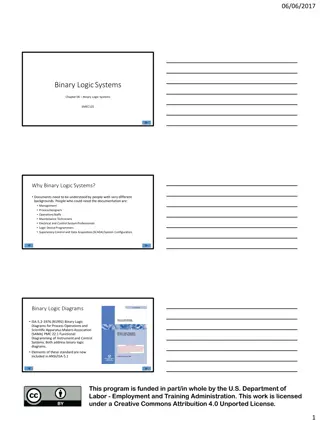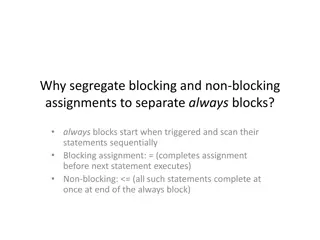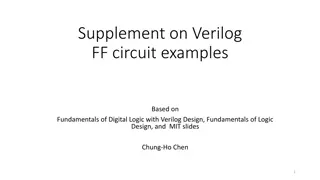
Verilog Combinational Circuit Examples for Digital Logic Design
Explore Verilog examples for conditional execution, mux circuits, signal states, and more based on the fundamentals of digital logic design with Verilog. Learn about different ways to implement conditional statements and understand signal states in digital circuits.
Download Presentation

Please find below an Image/Link to download the presentation.
The content on the website is provided AS IS for your information and personal use only. It may not be sold, licensed, or shared on other websites without obtaining consent from the author. If you encounter any issues during the download, it is possible that the publisher has removed the file from their server.
You are allowed to download the files provided on this website for personal or commercial use, subject to the condition that they are used lawfully. All files are the property of their respective owners.
The content on the website is provided AS IS for your information and personal use only. It may not be sold, licensed, or shared on other websites without obtaining consent from the author.
E N D
Presentation Transcript
Supplement on Verilog combinational circuit examples Based on Fundamentals of Digital Logic with Verilog Design By Brown/Vranesic 3rd. Chung-Ho Chen 1
Conditional Execution A MuX: Form 1 A = (x1< x2)? (B+1): (B); module mux_2to1 (x0, x1, s, f); input x0, x1, s; output f; If x1 < x2, A = B+1, else A = B; A MuX: Form 2 module mux_2to1 (x0, x1, s, f); input x0, x1, s; output reg f; assign f = s ? x1 : x0; endmodule Continuous assignment always @(x0, x1, s) f = s ? x1 : x0; endmodule always block 2
Conditional Execution A = (x1< x2)? (B+1): (B); A MuX: Two conditional bits declared in vectored signal If x1 < x2, A = B+1, else A = B; module mux_4to1 (x0, x1, x2, x3, S, f); input x0, x1, x2, w3; input [1:0] S; output f; s 0 s 1 s 1 s 0 f x 0 x 1 x 2 x 3 x0 x1 x 2 x 3 00 0 0 assign f = S[1] ? (S[0] ? x3 : x2) : (S[0] ? x1 : x0); 01 0 1 f 10 1 0 endmodule 11 1 1 First see if s1is 1, if true, then if s0is true: then f = x3 3
Conditional Execution using if else 2to1 MuX module mux_2to1 (x0, x1, s, f); input x0, x1, s; output reg f; module mux_2to1 (x0, x1, s, f); input x0, x1, s; output reg f; always @(x0, x1, s) if (s==0) f = x0; else f = x1; always @(x0, x1, s) f = s ? x1 : x0; endmodule endmodule 4
Conditional Execution Using case module mux_4to1 (x, s, f); input [0:3] x; input [1:0] s; output reg f; module mux_2to1 (x0, x1, s, f); input x0, x1, s; output reg f; always @(x0, x1, s) if (s==0) f = x0; else f = x1; always @(x, s) case (s) 0: f = x[0]; 1: f = x[1]; 2: f = x[2]; 3: f = x[3]; endcase 2 b00 endmodule endmodule 5
Signal states: 0, 1, z, or x High impedance state z: output behaves like an open circuit and not connected to any defined voltage value. Don t care state x: does not matter whether a given logic variable has the value of 0 or 1. 6
Example of using casex module priority (U, Y, z); input [3:0] U; output reg [1:0] Y; output reg z; U3 U2 U1 U0 y1 y0 always @(U) begin z = 1; casex (U) z 0 0 0 0 d 0 0 1 1 d 0 1 1 1 0 0 0 1 0 0 1 x 0 1 x x 1 x x x 0 1 0 1 4'b1xxx: Y = 3; 4'b01xx: Y = 2; 4'b001x: Y = 1; 4'b0001: Y = 0; default: begin 1 z = 0; Y = 2'bx; end U3 has the highest priority. endcase end endmodule 7
Verilog Operators Bitwise OR Bitwise AND A[2:0], B[2:0]; f, w is scalar & | 0 1 x 0 1 x 1. f = A & B, (bitwise and) 0 0 0 0 0 0 1 x only the least significant bits are involved, ie, f = A[0] & B[0]; 1 0 1 x 1 1 1 1 x 0 x x x x 1 x 2. f = !A; f = 1 only if all bits in A are 0, ie, f = ~(a2 +a1 +a0). Bitwise XOR Bitwise XNOR 3. f = A && B; f=(a2+a1+a0) . (b2+b1+b0) ^ ~ ^ 0 1 x 0 1 x 4. f =&A; f = a2.a1.a0. (reduction and) 0 0 1 x 0 1 0 x 5. Concatenate and Replication: {3{A}}= {A,A,A} = a2a1a0a2a1a0a2a1a0 1 1 0 x 1 0 1 x x x x x x x x x 8
Using Task in Verilog 4 Inputs of 16to1 Task: circuit routine for replication Output of a task must be a variable. The task must be included in the module that calls it. A task can call another task and it may invoke a function. 9
Using Function in Verilog Function: circuit function for invocation Return a single value which is placed where the function is invoked. A function can call other function but cannot call a task. Input Return one of the inputs (W12-15) 10






















